On the 18th of February 2013 the planet Jupiter and our Moon had a meeting in the night sky. For most of the world it was visible in what is know as a conjunction, where Jupiter and The Moon are close together. However there was a relatively narrow strip of the Earth where Jupiter would actually pass behind The Moon in what is called an occultation.
The place where I live in southern Australia was just outside of this occultation path by about 50km. If I stayed home I would see Jupiter and The Moon very close together indeed, but at no time would Jupiter disappear. I wanted to photograph and observe a proper occultation so it meant packing all my telescope and photography gear into my car and heading further south.
After checking the weather and cloud forecasts and figuring in travel and setup times I decided on a general location, actually not too far from where I grew up in central Victoria. After driving about 200km I arrived at my chosen location at about 10:30pm and I had my telescope aligned and up and running by 11pm. Jupiter was due to start its pass behind the moon at about 11:40pm.
The equipment I was using for this shoot was a 10inch (250mm) F/4 Newtonian Telescope mounted on an NEQ6 Pro Telescope Mount. The telescope has a native focal length of 1000mm. The camera I decided to use was a Canon 60D which is directly hooked into the focuser of the telescope by way of some adapters. As this camera is not a full frame camera it has a crop factor of x1.6. So I was effectively taking images of The Moon and Jupiter at a focal length of 1600mm (1000 times 1.6). The mount is a tracking mount so once it is setup properly it can follow objects in the night sky and keep them centered in the field of view by countering the effects of the rotation of the Earth.
I had the camera imaging The Moon and Jupiter at about 10 second intervals when I noticed the lights from a plane close to the moon. I realised that there was a chance that it would pass in front of the moon, so I quickly canceled the remote timer I was using to take the shots and instead started shooting high speed continuous frames. I lost the plane in the glare from The Moon as it got closer so I wasn’t entirely sure if I had got it or not. After a minute (long enough for the plane to have passed by) I stopped shooting frames and went back through the images on the camera. It was a good thing that I was on a deserted country road because my scream of excitement would have echoed for miles. I had managed to get the plane crossing the moon in five individual frames just as Jupiter was about to be occulted by The Moon, as well as a further 7 or so frames with the dissipating jet trail. I knew right then that I had captured something unique.
“Fly Me To The Moons”
The image above is a two image composite. Click to enlarge. The Moon, Jupiter and the plane are all one single image. I then took an overexposed image to bring up the Galilean Moons of (from left to right) Io, Callisto and Europa. Ganymede had already been occulted by The Moon.
I thought it would be fun to make all the plane transit images into an animated GIF. I have to give a big thanks to Russell Preston Brown at Adobe for his help with this. Russell made a tutorial, featuring all of my plane transit images, in which he explains how the above animation was created here: http://youtu.be/fQzp-fEeqY0
A behind the scenes look at my telescope imaging the Jupiter and Moon occultation. Note how low in the sky The Moon was at the time which made the seeing conditions less than ideal so I couldn’t get as much detail in the Moon and particularly Jupiter as I would have liked.
Nancy Atkinson from Universe Today wrote a lovely article labeling it “Luckiest Photo Ever”. Not quite sure about that but I am certainly not complaining. You can read that article here: http://www.universetoday.com/100097/luckiest-photo-ever-the-moon-jupiter-and-more/
Update (25th of February,2013) APOD!!!!!!!!!!!!!
Featured as the Astronomy Picture Of the Day http://apod.nasa.gov/apod/ap130225.html
Yes, I was very lucky to get this shot. I don’t know if I will ever top it, but I will continue to go out into the night and point my cameras at the sky. You just never know…….
Greg
.

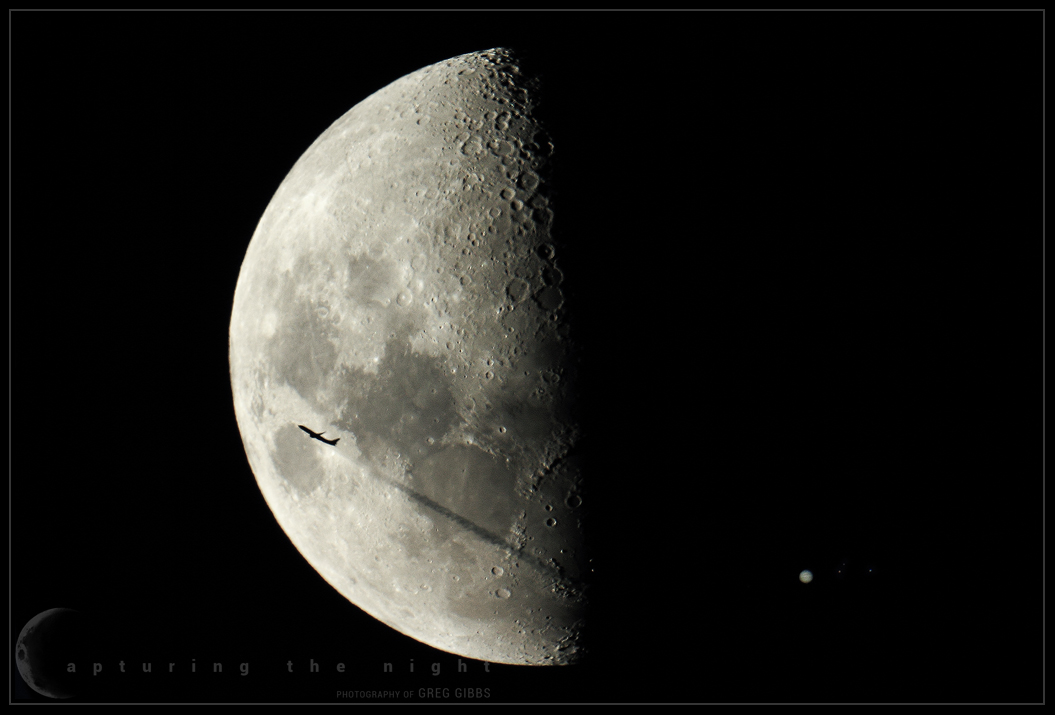
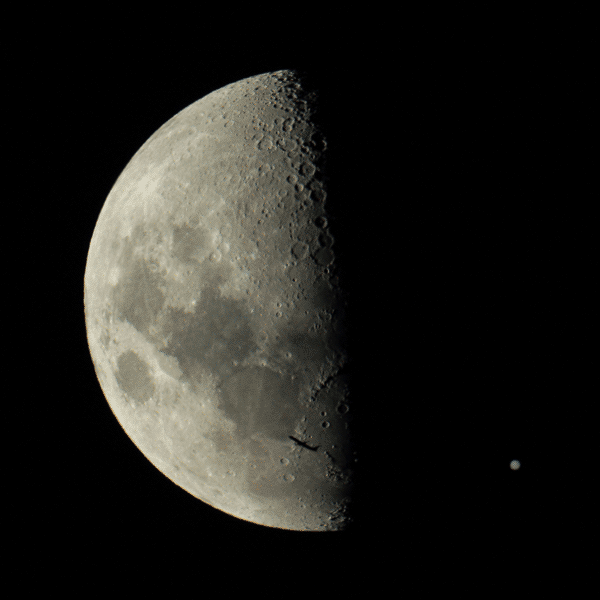
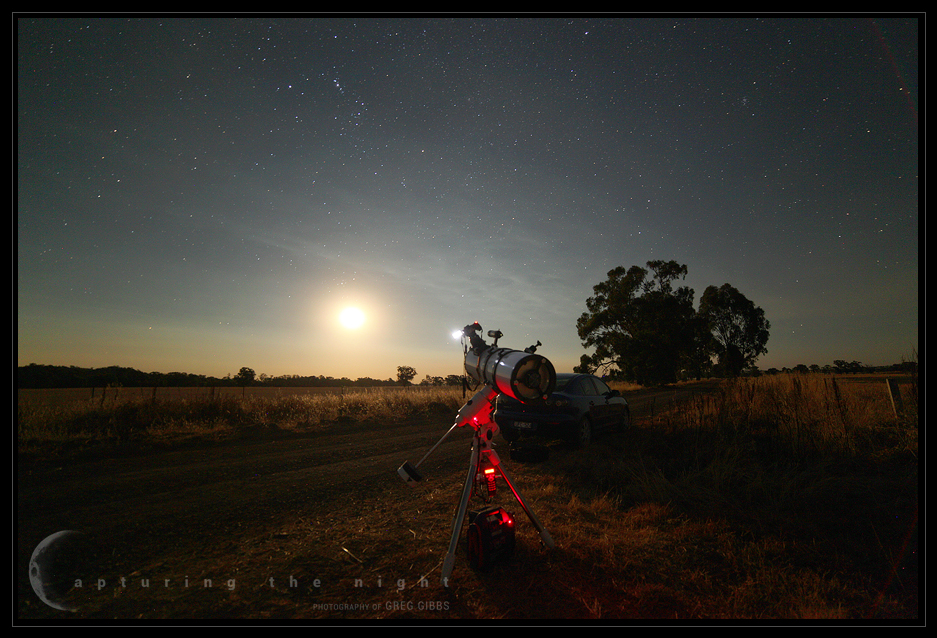
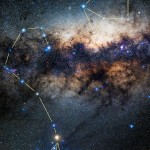
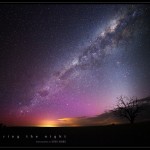
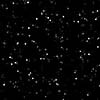
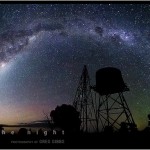
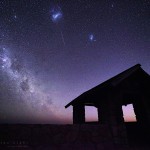
I can’t believe you don’t any comments here yet…I first became aware of your image through APOD so I followed the links through to here. Congratulations on this stunning and unique image, not just because you captured the plane flying in front of the Moon, but also because you managed to capture Jupiter and moons in there as well – I know these kind of shots aren’t just all luck like a lot of people tend to believe…a lot of planning and dedication is also involved. I sure know that feeling when you finally manage to capture something like this!
Thank you so much for commenting and the great feedback Mark. I really appreciate it.
Great picture, but I can only find 2 of the 3 moons of Jupiter no matter how carefully I look when I enlarge the picture.
Thank you very much If you look just above and to the right of the moon closest to Jupiter you should be able to spot it. It’s fainter, but it is there.
If you look just above and to the right of the moon closest to Jupiter you should be able to spot it. It’s fainter, but it is there.
I did, & I found it. Now that I see it, I am asking myself how I missed it in the 1st place.
The picture of the year
Thank you very much
Great picture.
Thank you very much
G’day Greg
I have just posted a response to your last comment on the APOD Forum which should answer your question.
Low Cost Carriers like Jetstar usually run late at end of day and 60 to 90 minutes being behind Schedule is nothing unusual.
Regards Tony
Hi Tony,
Thank you so much for your sleuthing efforts. That radar archive was fascinating to watch and is exactly the sort of thing I was trying to find online. Do you know which plane the one on the same flight path but in front of the Jetstar plane was? My reason for asking is that the Jetstar one might have been a few minutes late to cross the moon at the time of the shot. Jupiter was pretty much behind the moon between the 23:43 and 23:49 time period. My image was taken before Jupiter started to go behind the moon at about 23:34 so the plane before that one might be the one I captured.
Thank you so much again.
Cheers
Greg
P.S. What aviation forum has this been discussed on? I would be interested in reading the discussion.
I saw two posts with 1140 and1152 re sydney and when i read your lat/long with no time i presumed ok .You mentioned wnw so i went for 270 to 330 degrees.
The aircraft in front by 12 minutes was VH-YFC Boeing 737-800 on Flight Voz 356 Bris-Melb.
The AC Locations on the adop forum are near identical except the time now 2231 t0 2237 and altitude now 40000down to 33000 .
Is there a way to amend my forum post or would i do a correction if the latter please give me estimate of the time.
A/C speed 13 Km per min .thanks tony
Image was taken at 23:35 so, yes, that must be the one then. I think that a lot of the times that people were coming up with was based on when Jupiter was occulted by The Moon.
You might be able to edit your post if a certain amount of time has not elapsed, otherwise I would just post another reply if you wish.
Thanks again mate. I think we can finally put that little mystery to rest.
First Para I agree plus “plane crossing the moon in five individual frames just as Jupiter was about to be occulted by The Moon”.
I added a Correction post thanks.Re your earlier P.S no discussion I follow daily a aviation blog called Plane Talking on Crikey.com.au . He had a article on 2 comets with a link to APOD Index saw your entry and here i am.All the best Tony
Hi Greg,
First, I’d like to say your pictures are great and what a great event to experience! Congratulations on making it to the APOD. I’ve been involved with trying to understand your location and times, and it’s my nature to see things come together like a puzzle. The link that Tony gave is really a great tool that I’ve used to explore everything in more detail.
So, I’ve been plagued by the ~2-minute difference between your listed 23:35 (12:33 UT) time and the flight radar time for the identified flight. After much careful detailed analysis, I believe the time for your picture is actually between 12:32:44 UT and maybe 12:33:00 UT. I have three reasons: 1. Much better agreement with the flight radar, 2. Jupiter’s position to the dark limb is too far away for a 12:35 time, and lastly, in your picture, Ganymede is BARELY visible! As you say, it is occulted, but through diffraction or exposure timing, there is a very faint blob or flare that is exactly in Ganymede’s location! Albeit faint, you did capture Ganymede!! Ganymede’s predicted occultation time for your location was 12:32:39 with 2nd contact happening ≈4.4 seconds later. I conservatively added an additional 16 seconds (~2 Ganymede diameters deeper into the occultation).
Overlapping your picture and ephemeris locations for Jupiter and its satellites shows Ganymede right on the lunar limb! I can’t share these pictures here, but I convinced of the eariler exposure time. I was suspicious of Ganymede’s proximity to the limb when I looked at Jupiter’s location in detail. Everything makes sense.
Oh, I don’t know if you looked, but my calculations say the 2nd plane would have transited the moon too. More towards the top (southern) side. The 2nd plane flew at a lower altitude which compensates for the lower moon position.
Thanks again, and keep up the good work!
Jon
Hi Jon, )
)
Thank you so much for the great feedback on my work. To be honest the 23:35 time was arrived at by looking at the time stamp on my camera which I know is not truly accurate. I did try and set it to the correct time when I set up the camera, but I certainly would not be surprised if it was a minute or two out now. I would certainly side with the radar times. I am happy to stand corrected and say that the image was taken at or just before 23:33 AEDST. (Must make sure my cameras time stamp is accurate next time…….
I did not even know that I had captured Ganymede as well. Thanks heaps for pointing that out. I just went a stretched the original file and yes you are right, there is definitely a faint blob right where it should be. There must have been a slither of it right on the limb still. Awesome!
If the second plane did transit the moon then I didn’t see it or capture it on camera. Once Jupiter was fully occulted I stopped taking images until it started to emerge again, and did a few “behind the scenes” wide field images like the one above. It could well have happened during that lull in activity.
Thanks again Jon.
Kind Regards
Greg
Glad your work paid off Greg, truly unique story and shots